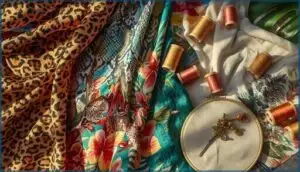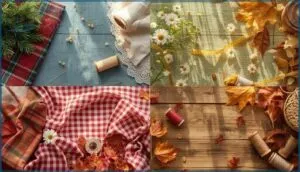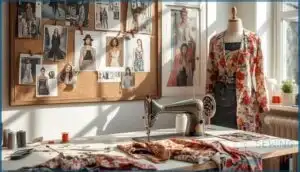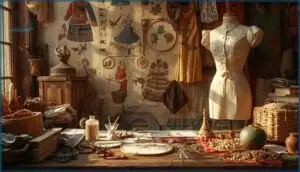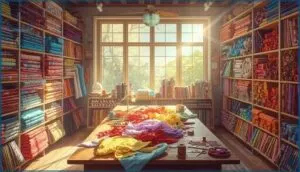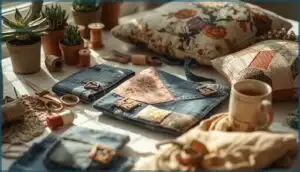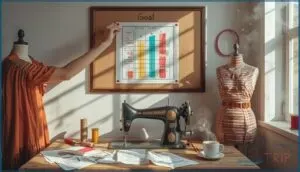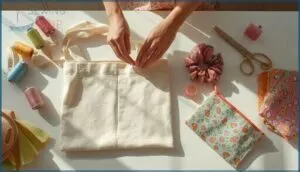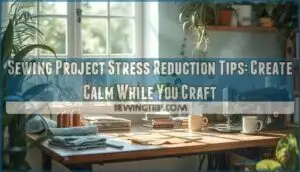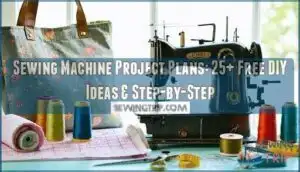This site is supported by our readers. We may earn a commission, at no cost to you, if you purchase through links.
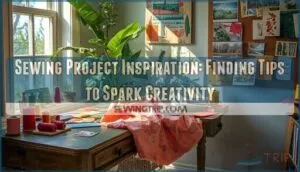
Your latest sewing project sits unfinished in the corner, and your sewing machine hasn’t hummed in weeks. You’re not alone—creative blocks hit every sewist, whether you’ve been stitching for months or years. The difference between makers who push through and those who let their machines gather dust? They’ve mastered the art of finding fresh sewing project inspiration when motivation runs dry.
Research shows that adults engaged in textile arts see stress drop by 28%, but only when they stay connected to sources that reignite their creative spark. From nature’s color palettes to vintage patterns and online communities, countless wellsprings of ideas wait to transform your next project from “maybe someday” into “I can’t wait to start.
Table Of Contents
- Key Takeaways
- Why Finding Sewing Inspiration Matters
- Exploring Nature for Sewing Ideas
- Drawing Inspiration From Fashion Trends
- Historical and Cultural Sewing Influences
- Leveraging Online Sewing Communities
- Visiting Fabric Stores for Creative Sparks
- Using Sewing Books and Magazines
- Upcycling and Sustainable Project Inspiration
- Setting Personal Challenges and Goals
- Building Confidence Through Beginner Projects
- Frequently Asked Questions (FAQs)
- Conclusion
Key Takeaways
- Exploring nature, fashion trends, and global cultures fuels fresh sewing ideas and keeps your creativity alive.
- Connecting with online sewing communities, workshops, and step-by-step guides helps break creative blocks and builds skills faster.
- Upcycling fabrics and setting personal challenges turn forgotten materials and scattered ideas into finished projects with purpose.
- Visiting fabric stores, using sewing books, and tracking your progress inspire new designs and boost confidence one stitch at a time.
Why Finding Sewing Inspiration Matters
You know that feeling when you sit down at your sewing machine and stare at your fabric stash, completely blank on what to make? Finding fresh inspiration isn’t just about beating boredom—it’s what keeps your creative spark alive and your skills growing.
Let’s look at why tapping into new ideas matters for your sewing journey.
Boosting Creativity and Motivation
Sewing inspiration acts as the spark that fuels your creative fire. Fresh ideas can transform your craft by boosting motivation and unlocking new possibilities. Adults engaged in textile arts saw stress drop by 28%, while aesthetic motivations and eco-utility drive many to pick up their needles. Many find inspiration by exploring cultural and traditional crafts.
Consider these benefits:
- Goal setting increases project completion
- Skill diversity builds confidence
- Community pride strengthens connections
Enhancing Sewing Skills Through New Ideas
Fresh creative ideas push your sewing skills forward through technique adaptation and project complexity. Structured learning with visual guides can jump your grades from C+ to A+, while skill diversification through varied sewing projects increases your completion rate by 35%.
The process can also include a recognised qualification, enhancing career prospects. You’ll master creative problem-solving as you tackle new sewing techniques—turning inspiration into tangible progress with every stitch you take.
Overcoming Creative Blocks
Even when skills grow, 63% of sewers hit creative walls each year. These psychological roadblocks can stall your momentum for days or even years. That’s where sewing inspiration becomes your lifeline. Break through blocks with:
- Mindful sewing reduces creative anxiety by 68%
- Routine changes like workshops double motivation
- Environmental adjustments cut project barriers by 76%
- Collaborative interventions through sewing challenges jumpstart stalled work
Fueling your creative fire means having strategies ready.
Exploring Nature for Sewing Ideas
Nature is one of the best places to find fresh sewing inspiration. The colors, textures, and patterns you see outdoors can transform your next project from ordinary to remarkable.
Here’s how you can tap into the natural world around you to fuel your creativity.
Using Natural Color Palettes
Nature’s palette offers sewing inspiration like no other. Earth-tone trends dominate fashion collections, with terracotta, sage green, and oceanic blue making up over 45% of current designs. These sustainable textiles, using eco-friendly dyes, reduce water pollution markedly, while seasonal palettes give your projects timeless appeal. Color psychology shows natural hues improve design balance for 71% of sewists.
| Color Family | Popular Shades |
|---|---|
| Warm Neutrals | Sand, Linen, Ochre |
| Cool Earth Tones | Sage, Forest Green, Powder Blue |
| Rich Organics | Terracotta, Rust, Chocolate |
| Soft Pastels | Lavender, Blush Pink |
| Deep Naturals | Bark Brown, Olive |
Incorporating Floral and Animal Patterns
When you blend bold botanicals with wild animal prints, your sewing projects come alive with personality. Floral embroidery and nature textiles account for nearly 45% of craft sector growth, making pattern mixing a smart creative choice. Try these trending combinations:
- Leopard print with abstract botanical forms
- Tropical hibiscus paired with zebra accents
- Snake prints on sustainable fabrics
- Cow print mixed with monstera leaves
- Lifelike animal motifs alongside plumeria blooms
These sewing patterns transform everyday fabric into wearable art.
Seasonal Inspiration for Projects
Sewing projects naturally shift with the calendar. Holiday decor demands jump 65% from October through December, pulling you toward festive patterns in tartan and fleece. Spring awakens lighter fabrics and picnic themes, while autumn sewing guides you back to cozy textures.
Smart sewists plan winter crafts one season ahead, boosting completion rates by 33% and transforming seasonal fabrics into timely treasures.
Drawing Inspiration From Fashion Trends
Fashion trends aren’t just for the runway—they’re a goldmine for your next sewing project. You can transform high-fashion looks into pieces you’ll actually wear, all while building your skills and staying current.
Here’s how to tap into the fashion industry for fresh ideas that fit your style and your machine.
Adapting Runway Looks to Home Sewing
Want to bring designer inspiration straight from the catwalk to your sewing room? Adapting runway trends doesn’t require a luxury budget. With smart sewing pattern hacks and the right runway fabric choices, you can transform fashion trend forecasts into wearable pieces.
Here’s how to tackle common home sewing challenges:
- Study designer collections closely to identify key silhouette details you can replicate
- Choose fabric weights that match the drape shown in runway trends
- Start with simpler adaptations before attempting complex couture techniques
Following Influencers and Designers
Instagram has become a goldmine for sewing inspiration, with top influencers like Mimi Goodwin attracting over 471,000 followers. Designer collaborations and sewing challenges connect you to fashion trends and online communities in real time.
Following sewing blogs and joining online workshops helps you explore designer collections while building skills.
Social media trends showcase sustainable practices, step-by-step tutorials, and diverse project styles that fuel your creative journey.
Translating Trends Into Wearable Projects
Fashion trends become your design playground when you learn to decode them for home sewing. Over 67% of indie patterns released in 2025 translate runway color palettes directly into wearable projects.
You can adapt maximalist textures, incorporate sustainable materials like certified recycled fabrics, and even experiment with smart fabrics.
Trend forecasting tools help you select patterns six months ahead, transforming designer collections into creative ideas that fit your lifestyle and sewing inspiration goals.
Historical and Cultural Sewing Influences
Looking backward can move your sewing forward in ways you never expected. History and culture hold centuries of design wisdom, from the elegant silhouettes of past decades to the intricate techniques passed down through generations.
Here are three powerful ways to weave these timeless influences into your modern projects.
Vintage Styles and Retro Patterns
Vintage sewing brings fashion history right to your fingertips. You can explore over 83,500 retro patterns spanning the 1920s to 1992, discovering classic designs that shaped entire decades.
Retro fabric choices and pattern revival projects let you recreate iconic looks from the 1950s New Look era or 1960s Mod mini dresses.
Historic textiles offer timeless inspiration while helping you build a wardrobe that celebrates both nostalgia and individual style.
Traditional Textile Techniques
Traditional textile techniques like hand weaving and embroidery arts connect you to centuries-old craftsmanship. Natural dyeing and Shibori techniques bring organic beauty to your work—Japan’s Shibori has fewer than 350 active practitioners keeping these methods alive.
Try tapestry making or hand sewing with embroidery floss to explore textile crafts rooted in cultural and traditional crafts that inspire truly unique, story-rich projects.
Global Motifs and Ethnic Designs
Explore cultural patterns and ethnic textiles that weave stories into every stitch. Global inspirations from symbolic motifs to traditional embroidery turn your projects into wearable art. The ethnic wear market hit $90.8 billion in 2024—showing how cultural and traditional crafts resonate worldwide.
Here are ways to incorporate these designs:
- Geometric patterns from African textiles add bold visual impact
- Floral motifs from South Asian fabrics bring vibrant color palettes
- Symbolic embroidery from Middle Eastern traditions creates meaningful details
- Vintage styles with historical influences blend past and present beautifully
- Fusion designs mix ethnic elements with contemporary silhouettes for fresh looks
Leveraging Online Sewing Communities
Online sewing communities are like a fabric store that never closes—they’re packed with ideas, support, and inspiration whenever you need them. You’ll find endless project examples, helpful advice, and people who genuinely get excited about your latest creation.
Here’s how you can tap into these digital spaces to spark your next sewing adventure.
Participating in Forums and Social Media Groups
Dive into online sewing communities where thousands of makers share daily inspiration and support. Facebook groups like “Sew for Boys” house over 100,000 members, while specialized forums cover everything from embroidery to quilting. You’ll find monthly sewing challenges that spark creativity—groups like @sewover50 generate hundreds of entries each cycle. Over 80% of sewists use these spaces to troubleshoot techniques and discover new patterns before starting projects.
| Community Type | Key Benefits |
|---|---|
| Facebook Groups | Daily tutorials, pattern swaps, thousands of active members |
| Specialized Forums | Niche techniques, organized pattern libraries, expert advice |
| Instagram Challenges | Monthly themes, wardrobe reflection, skill development |
| Regional Groups | Local meetups, swap events, in-person collaboration |
Engaging With Collaborative Pinterest Boards
Pinterest boards offer something special: collaborative spaces where sewists worldwide curate sewing inspiration together. Join a board with active contributors and watch your project ideas multiply. These online communities thrive on smart board management and content strategy—members share patterns, techniques, and fabric finds daily. Pin organization helps you track everything from zipper tutorials to color palettes. Here’s how collaborative tools transform your creative process:
- Discover diverse project styles from international contributors who pin everything from vintage patterns to modern minimalist designs
- Save step-by-step tutorials that guide you through techniques shared by experienced makers in sewing blogs and social media
- Track seasonal trends as boards showcase what’s popular across sewing communities, from holiday projects to wardrobe staples
- Build connections through community engagement—comment on pins, share your finished projects, and exchange fabric recommendations with fellow creators
Learning From YouTube Tutorials and Blogs
Video lessons transform how you master sewing techniques and tutorials. YouTube channels and sewing blogs deliver visual guidance that boosts understanding by 96%—far surpassing textbook learning. Tutorials under 15 minutes keep you engaged, while blog engagement through project reviews sparks motivation. Online workshops connect you to a thriving sewing community and inspiration.
| Resource Type | Best For |
|---|---|
| YouTube Tutorials | Step-by-step visual demonstrations |
| Sewing Blogs | Detailed written guides and reviews |
| Online Workshops | Live instruction and Q&A sessions |
| Tutorial Reviews | Finding quality content quickly |
| Community Forums | Troubleshooting and peer support |
Visiting Fabric Stores for Creative Sparks
Walking into a fabric store is like stepping into a treasure chest of color, texture, and possibility. Every aisle holds something that can jumpstart your next project or take your sewing in a whole new direction.
Here’s how to make the most of your visit and turn browsing into real creative fuel.
Discovering New Fabrics and Textures
Stepping into fabric stores is like entering a treasure chest of texture and possibility. With 38% more sewists choosing new textures over familiar cottons in 2025, you’re joining a movement.
Run your hands over bouclé, velvet, and sustainable textiles—each offers a different creative spark. From high-tech fabrics to cutting-edge materials, discovering what speaks to you transforms ordinary projects into something remarkable.
Attending In-Store Workshops
In-store sewing workshops spark growth in ways solo stitching can’t. When 85% of participants report sharper skills and 78% feel a creativity boost, you know something special is happening.
These classes offer:
- Hands-on skill enhancement that sticks 40% better than self-teaching
- Creative networking with sewists who share your passion
- Project feedback that refines your technique
- Sewing community connections that last beyond the final stitch
Workshop benefits extend far beyond the classroom door.
Finding Unique Notions and Supplies
Those hidden corners of fabric stores hold treasures you won’t find online. Vintage buttons with history, rare threads in unexpected hues, and eco notions that make your projects sing.
Hunt through bins of fabric scraps for embellishment techniques that set your work apart. Online communities point you to specialty sewing supplies, but nothing beats touching unique finds that spark your next creation.
Your sewing tools collection deserves these gems.
Using Sewing Books and Magazines
Sometimes the best inspiration sits right on your bookshelf. Sewing books and magazines offer a treasure trove of ideas, from tried-and-true patterns to fresh techniques you haven’t explored yet.
Here’s how these classic resources can keep your creativity flowing.
Pattern Books for Project Variety
Pattern books are like treasure chests for your sewing space—each one packed with 20 or more unique designs ready to spark fresh project planning. You’ll find everything from casual wear to vintage styles, giving you pattern variety that keeps fabric selection exciting.
These collections boost skill development by exposing you to new sewing techniques, construction methods, and pattern drafting approaches that expand your creative repertoire.
Step-by-Step Guides for Skill Building
Think of step-by-step guides as your personal sewing mentors—they walk you through sewing techniques with visual clarity that builds real confidence. These tutorial videos and sewing video tutorials reduce errors by 37% compared to text alone.
Online sewing communities enhance learning through shared experiences.
You’ll master sewing patterns faster when skill assessment meets structured project planning, transforming fabric selection from guesswork into creative certainty.
Magazine Features on Trending Projects
Beyond step-by-step tutorials, magazine patterns deliver fresh sewing inspiration through curated fashion forecasts. Publications like Threads and Burda Style spotlight sustainable sewing and indie designs with 15-25 sewing projects per issue. You’ll discover:
- Retro-inspired prints channeling 1960s-1980s aesthetics
- Puffy silhouettes and oversized garment trends
- Bold florals and boho-inspired textile choices
- Pop culture-inspired embroidery ideas
- Eco-friendly fabric recommendations from independent designers
These creative ideas transform fashion runways into wearable reality.
Upcycling and Sustainable Project Inspiration
Upcycling breathes new life into materials you already own while reducing waste. It’s a creative way to turn forgotten fabrics into something fresh and functional.
Here are three sustainable approaches that’ll spark your next eco-conscious project.
Repurposing Old Clothes and Linens
Your old clothes hold untapped potential for sustainable sewing and eco-friendly crafts. Textile reuse transforms worn garments into fresh creations—turn vintage linens into pillowcases, or repurpose curtains into handsewn aprons.
Fabric recycling through upcycled fashion reduces waste while sparking creativity. Try upcycling vintage doilies into elegant table runners or crafting reusable gift bags.
Upcycling fabric breathes new life into forgotten textiles, making sewing for gifts both meaningful and planet-friendly.
Transforming Scraps Into New Creations
Fabric scraps become mini masterpieces with creative reuse! Stitch together patchwork coasters for upcycled home decor, or weave strips into colorful bookmarks.
These sustainable sewing projects teach precision while reducing waste—one scrap fabric art piece at a time.
Try repurposed accessories like button-adorned headbands or DIY sewing pouches. With creative sewing tutorials guiding you, upcycling transforms leftovers into charming, functional treasures you’ll love showing off.
Eco-Friendly Sewing Ideas
Your creative scraps deserve a greener purpose! Swap plastic bags for reusable shopping totes or produce mesh bags—sustainable fabrics like organic cotton work beautifully.
Try beeswax food wraps or cloth napkins for zero waste kitchen swaps.
Ecofriendly sewing transforms repurposed textiles into DIY home decor that’s as kind to the planet as it’s stylish. Green crafting and eco sewing prove every stitch counts!
Setting Personal Challenges and Goals
Sometimes the best way to keep your sewing momentum going is to set a challenge that pushes your skills just a little further. Personal goals give you something to work toward, whether you’re tackling new techniques or simply finishing more projects.
Here are three ways to create sewing challenges that keep you inspired and growing.
Monthly Project Themes
Imagine tackling a fresh creative prompt every single month to keep your sewing inspiration flowing! Monthly project themes turn your year into a vibrant runway of ideas. You’ll boost your skills and complete an average of 2.25 sewing projects per month with focused theme planning.
- April: Blouse Making – Perfect spring garments
- May: Me Made May – Wear your handmade wardrobe daily
- August: Reversible Sewing – Double-sided creative prompts
- September: Charity Dresses – Over 13,000 sewn worldwide
- October: Upcycled Projects – Sustainable themed patterns
Joining Sewing Competitions
Ready to level up your sewing game? Competitions push you beyond your comfort zone with structured deadlines and diverse sewing challenges. You’ll gain expert feedback from guest judges, connect with online sewing communities, and discover creative ideas you never imagined trying. Plus, prize incentives range from high-end machines to exclusive fabric bundles—with historic top awards reaching nearly $240,000!
| Competition Benefits | Skill Development | Prize Incentives |
|---|---|---|
| Structured deadlines | Pattern adaptation | Sewing machines ($999+) |
| Expert judging criteria | Precision techniques | Designer fabric bundles |
| Community connections | Sustainable practices | Professional tools |
| Creative sewing challenges | Construction quality | Workshop access |
| Confidence building | Design interpretation | Exclusive patterns |
Tracking and Celebrating Progress
Momentum builds when you document your personal growth and sewing journeys. Track project milestones using dedicated apps—68% of sewists rely on digital tools for managing patterns and time tracking. Progress journals boost motivation by 73%, turning finished seams into visible wins. Try these celebration strategies:
- Color-code each sewing project stage for clarity
- Share completed work with your sewing community
- Log hours spent to reveal your continuous learning
- Reward yourself with new creative ideas or supplies
Goal setting transforms scattered stitches into purposeful achievements.
Building Confidence Through Beginner Projects
Starting with beginner-friendly projects is like building your sewing wardrobe one stitch at a time—each finished piece adds another layer of skill and confidence. You don’t need to tackle complicated patterns right away to feel that rush of accomplishment.
Let’s look at three approachable project categories that’ll help you grow your abilities while creating things you’ll actually love and use.
Easy Accessories and Home Decor
Starting with accessories and home decor builds your sewing confidence fast. Pouches, scrunchies, and cushion covers are go-to projects—over 60% of beginners choose accessories first because they require less fabric and simpler techniques. You’ll master straight seams and enjoy quick wins. Plus, handmade accessories make perfect gifts!
Here are some easy sewing crafts to try:
| Project Type | Why It Works |
|---|---|
| Fabric pouches | Simple construction, high success rate |
| Tote bags | Practical, teaches bag-making basics |
| Scrunchies | Fast finish, trendy accessory trends |
| Cushion covers | Home decor staple with straight seams |
| Table runners | Uses scrap fabric, beautiful results |
Simple Garments and Kids’ Clothing
Kids’ clothing is a confidence-booster for sewing beginners! Smaller garments like elasticated shorts and simple dresses teach garment fitting without the pressure—kids grow fast, so excellence isn’t the priority.
You’ll practice fabric choices and sewing patterns on a manageable scale. Try beginner projects like kids rompers or swing dresses.
These hand sewing and machine sewing tips translate beautifully to adult garments later!
Gifting Handmade Creations for Motivation
Handmade gifts turn your sewing projects into emotional gifts that strengthen real connections. Making handsewn tokens like zipper pouches or scrunchies gives you purpose beyond practice.
Sustainable gifting through mindful crafting feeds both your skills and someone’s heart. The gift economy isn’t about flawlessness; it’s about showing you care enough to create something unique.
Handmade gifts aren’t about perfection—they’re about showing someone you care enough to create something just for them
Sewing for gifts transforms beginners into confident makers with every stitch!
Frequently Asked Questions (FAQs)
How do I organize my sewing inspiration collection?
Keep a digital folder for screenshots, pin ideas to inspiration boards, and use sewing journals to sketch designs.
Sort fabric by color or weight, and track ongoing projects with spreadsheets to stay organized and motivated.
What tools help capture ideas while shopping?
Ever wonder why some sewing ideas never slip away? Digital Notebooks, Idea Organizers, Voice Memos, Photography Apps, and Hybrid Planners help you instantly capture sparks of inspiration—right in fabric stores or the busy online world of sewing enthusiasts.
How can I adapt inspiration for skill level?
Start by evaluating your skill level with an honest Skill Assessment. Pick patterns that match, then try Pattern Modification, like swapping zippers for elastic.
Tackle Sewing challenges gradually—Project Scaling helps, and new Sewing techniques tips turn Creative Problems into Technique Mastery.
Where do professional sewists find commercial inspiration?
Curiously, most pros must look both outward and inward for ideas. Fashion weeks, fabric stores, social media, sewing blogs, online forums, runway collections, and cultural or traditional crafts all spark trends—while sewing challenges continually refresh their approach to finding sewing inspiration.
How do I balance multiple project ideas?
Juggling sewing projects gets a lot easier with Project Prioritization and Time Blocking. Break big tasks into bite-size wins, set realistic goals, and keep a workflow board visible—your Sewing ideas flow when your Task Management feels organized.
Conclusion
Sometimes, sparks start small: a swatch, a season, a single suggestion whispered by a wild idea. Sewing project inspiration finding tips aren’t just clever tricks—they’re the secret fabric woven into your craft journey.
Let fresh sources stir your senses and let your hands follow the fabric’s call. With every stitch, surprise yourself with what might bloom.
Sewing is more than fabric and thread; it’s the art of transforming moments of doubt into wearable bursts of joy.
- https://threadsmonthly.com/popular-sewing-projects-to-sell/
- https://www.youtube.com/watch?v=1ZdTH26km2s
- https://goodfabric.co.uk/sewing-ideas/sewing-instagram-accounts-to-follow/
- https://stylemakerfabrics.com/blogs/maker-resources/online-sewing-community
- https://blog.fabrics-store.com/2025/05/20/know-your-craft-why-i-analyze-my-practice-and-a-peek-into-my-data/


